外研(2019)版高中英语 必修第一册 Unit 6 At one with nature-Using language Attributive clauses课件(35张PPT)
文档属性
| 名称 | 外研(2019)版高中英语 必修第一册 Unit 6 At one with nature-Using language Attributive clauses课件(35张PPT) | 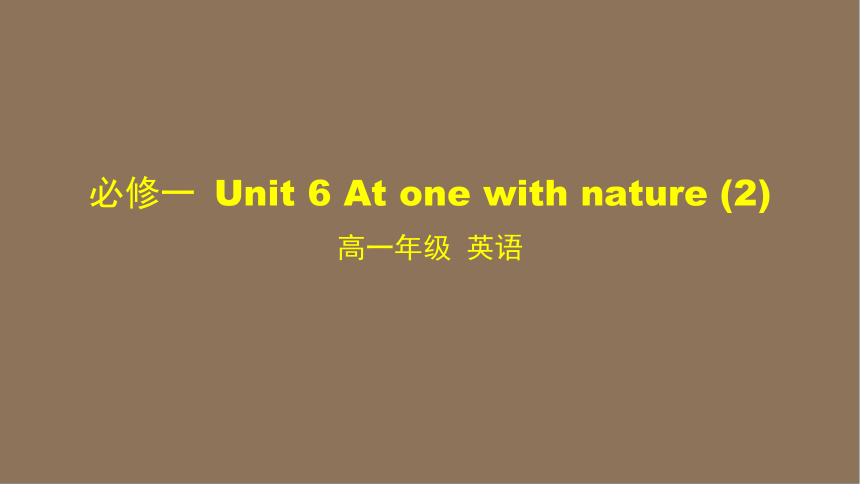 | |
| 格式 | zip | ||
| 文件大小 | 129.0KB | ||
| 资源类型 | 教案 | ||
| 版本资源 | 外研版(2019) | ||
| 科目 | 英语 | ||
| 更新时间 | 2021-02-05 07:47:39 | ||
图片预览

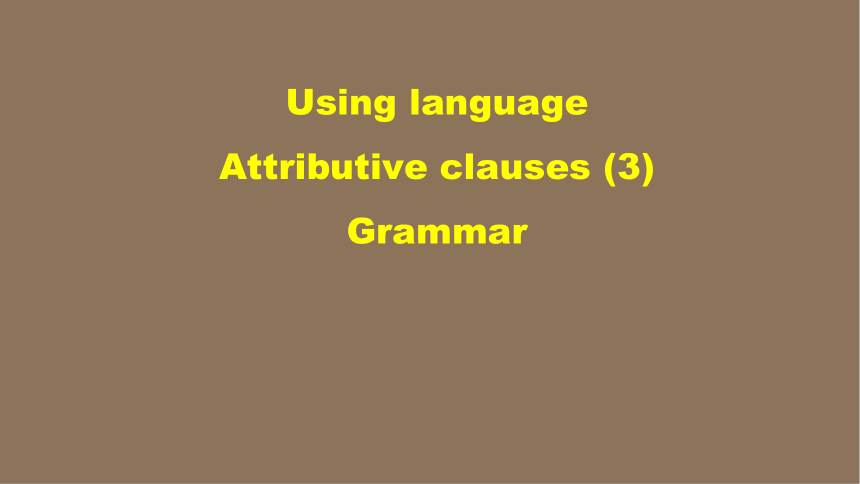
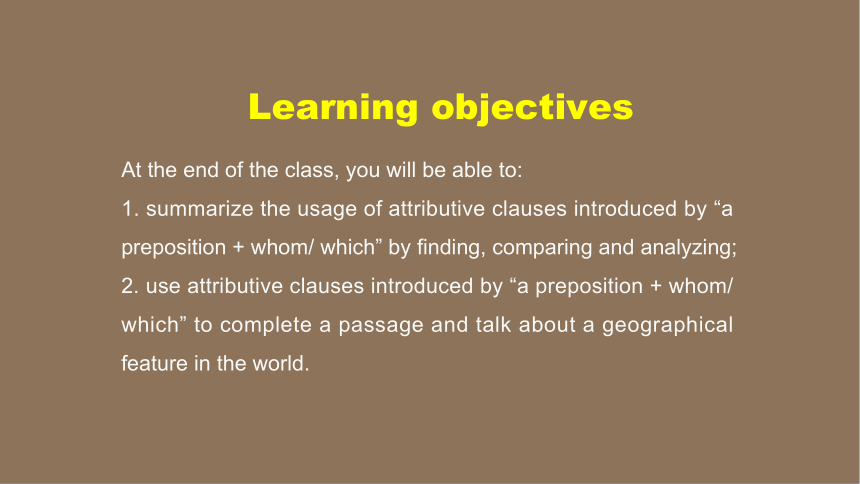
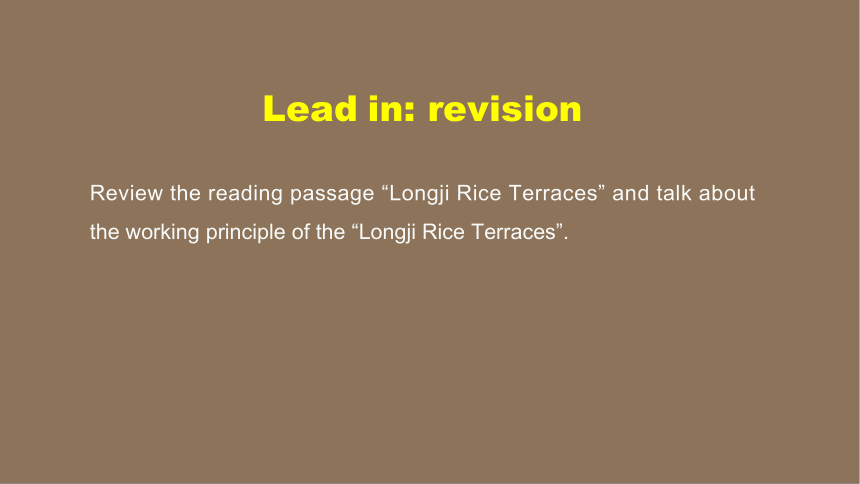
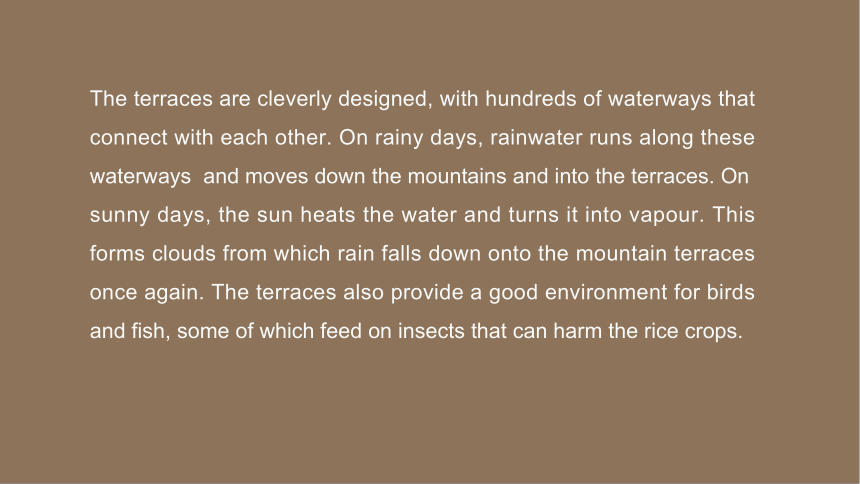
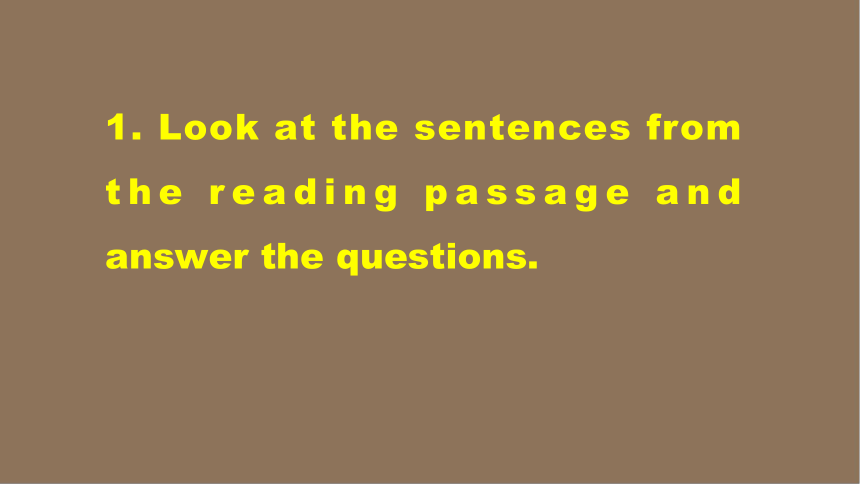
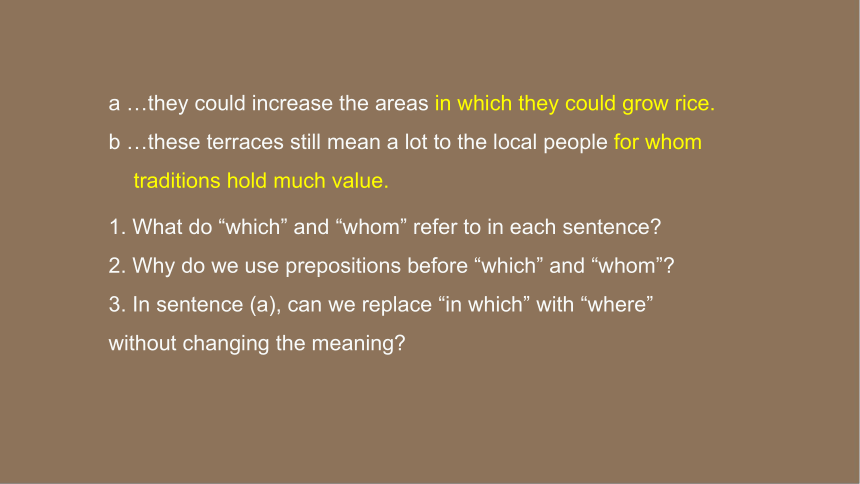
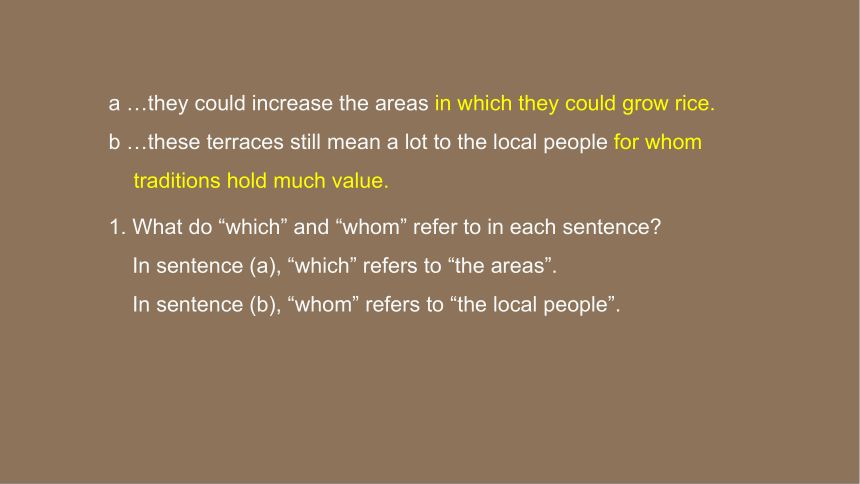
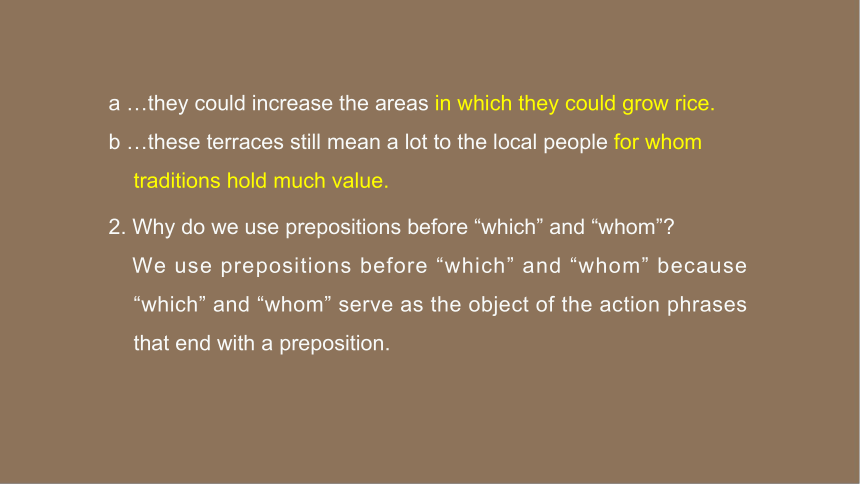
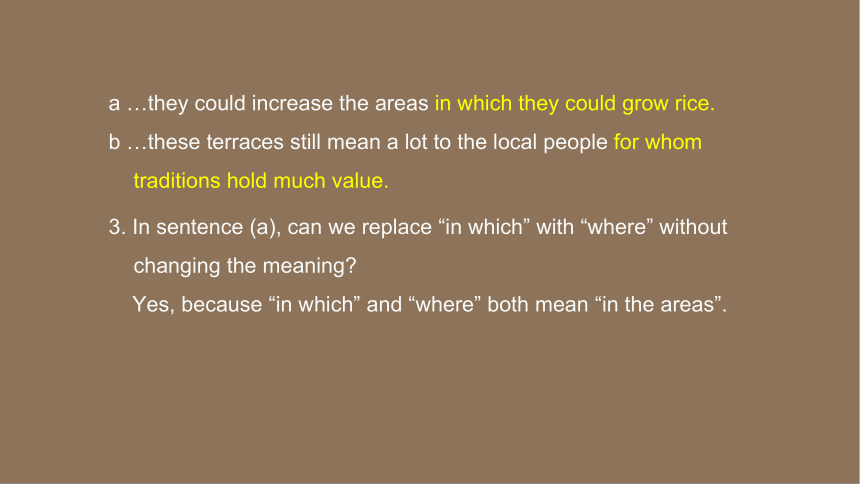
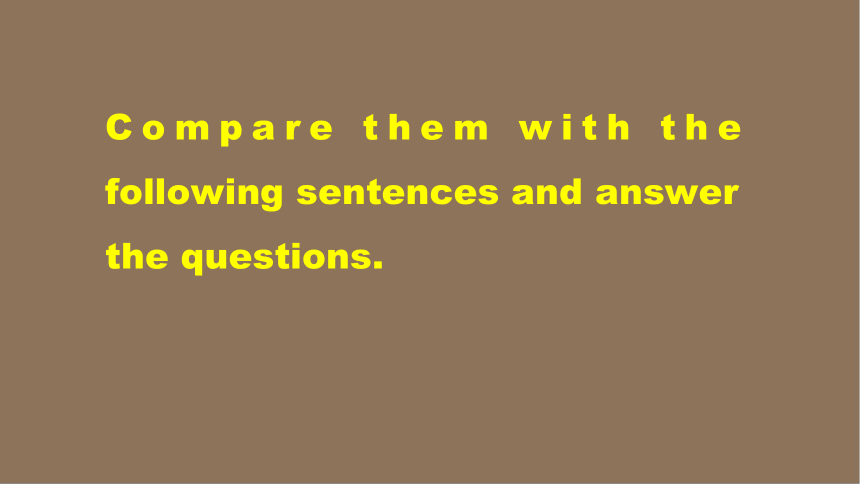
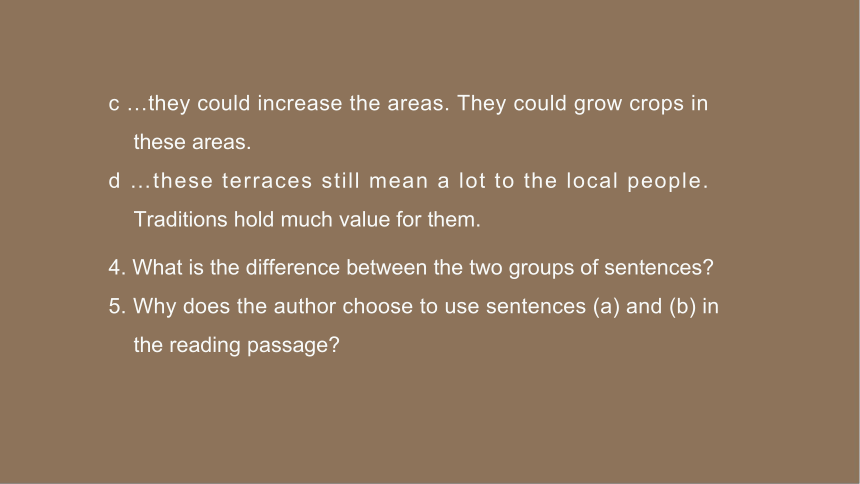
文档简介
(共35张PPT)
必修一
Unit
6
At
one
with
nature
(2)
高一年级
英语
Using
language
Attributive
clauses
(3)
Grammar
Learning
objectives
At
the
end
of
the
class,
you
will
be
able
to:
1.
summarize
the
usage
of
attributive
clauses
introduced
by
“a
preposition
+
whom/
which”
by
finding,
comparing
and
analyzing;
2.
use
attributive
clauses
introduced
by
“a
preposition
+
whom/
which”
to
complete
a
passage
and
talk
about
a
geographical
feature
in
the
world.
Lead
in:
revision
Review
the
reading
passage
“Longji
Rice
Terraces”
and
talk
about
the
working
principle
of
the
“Longji
Rice
Terraces”.
The
terraces
are
cleverly
designed,
with
hundreds
of
waterways
that
connect
with
each
other.
On
rainy
days,
rainwater
runs
along
these
waterways
and
moves
down
the
mountains
and
into
the
terraces.
On
sunny
days,
the
sun
heats
the
water
and
turns
it
into
vapour.
This
forms
clouds
from
which
rain
falls
down
onto
the
mountain
terraces
once
again.
The
terraces
also
provide
a
good
environment
for
birds
and
fish,
some
of
which
feed
on
insects
that
can
harm
the
rice
crops.
1.
Look
at
the
sentences
from
the
reading
passage
and
answer
the
questions.
a
…they
could
increase
the
areas
in
which
they
could
grow
rice.
b
…these
terraces
still
mean
a
lot
to
the
local
people
for
whom
traditions
hold
much
value.
1.
What
do
“which”
and
“whom”
refer
to
in
each
sentence?
2.
Why
do
we
use
prepositions
before
“which”
and
“whom”?
3.
In
sentence
(a),
can
we
replace
“in
which”
with
“where”
without
changing
the
meaning?
a
…they
could
increase
the
areas
in
which
they
could
grow
rice.
b
…these
terraces
still
mean
a
lot
to
the
local
people
for
whom
traditions
hold
much
value.
1.
What
do
“which”
and
“whom”
refer
to
in
each
sentence?
In
sentence
(a),
“which”
refers
to
“the
areas”.
In
sentence
(b),
“whom”
refers
to
“the
local
people”.
a
…they
could
increase
the
areas
in
which
they
could
grow
rice.
b
…these
terraces
still
mean
a
lot
to
the
local
people
for
whom
traditions
hold
much
value.
2.
Why
do
we
use
prepositions
before
“which”
and
“whom”?
We
use
prepositions
before
“which”
and
“whom”
because
“which”
and
“whom”
serve
as
the
object
of
the
action
phrases
that
end
with
a
preposition.
a
…they
could
increase
the
areas
in
which
they
could
grow
rice.
b
…these
terraces
still
mean
a
lot
to
the
local
people
for
whom
traditions
hold
much
value.
3.
In
sentence
(a),
can
we
replace
“in
which”
with
“where”
without
changing
the
meaning?
Yes,
because
“in
which”
and
“where”
both
mean
“in
the
pare
them
with
the
following
sentences
and
answer
the
questions.
c
…they
could
increase
the
areas.
They
could
grow
crops
in
these
areas.
d
…these
terraces
still
mean
a
lot
to
the
local
people.
Traditions
hold
much
value
for
them.
4.
What
is
the
difference
between
the
two
groups
of
sentences?
5.
Why
does
the
author
choose
to
use
sentences
(a)
and
(b)
in
the
reading
passage?
4.
What
is
the
difference
between
the
two
groups
of
sentences?
Sentences(a)
and
(b)
both
contain
a
clause
defining
a
noun
in
the
sentence.
Sentences
(c)
and
(d)
are
constructed
with
a
pair
of
simple
sentences,
with
one
defining
a
noun
in
the
other
sentence
in
each
pair.
5.
Why
does
the
author
choose
to
use
sentences
(a)
and
(b)
in
the
reading
passage?
The
author
chooses
to
use
sentences
(a)
and
(b)
1)
to
create
a
closer
link
and
connection
between
the
item
and
the
clause
defining
it.
2)
to
make
the
passage
clearer.
3)
to
emphasize
the
item
being
defined.
Attributive
clauses
introduced
by
a
preposition
+
whom/which
1.
We
usually
use
attributive
clauses
introduced
by
a
preposition
+
whom/which
when
the
relative
pronoun
is
the
object
of
a
preposition
in
the
attributive
clause.
E.g.
1)
The
man
by
whom
the
thief
was
caught
was
a
good
policeman.
2)
This
is
the
reason
for
which
I
was
praised
by
my
chemistry
teacher.
Attributive
clauses
introduced
by
a
preposition
+
whom/which
2.
The
preposition
is
determined
by
the
relative
pronoun(the
noun)
or
the
verb
in
the
clause.
E.g.
1)
This
is
the
land
on
which
the
great
author
grew
up.
2)
Peter
met
a
traveler
from
whom
he
learned
some
Spanish.
Attributive
clauses
introduced
by
a
preposition
+
whom/which
3.
Prepositions
in
a
set
phrase
are
usually
put
in
the
clause
instead
of
being
put
at
the
beginning.
E.g.
1)
The
children
(whom/who)
I
looked
after
in
the
nursery
brought
me
a
lot
of
joy.
2)
I
wanted
to
visit
the
house
(which)
my
grandparents
lived
in.
Look
for
more
sentences
with
attributive
clauses
like
these
in
the
reading
passage.
1.
These
terraces
were
built
by
the
local
Zhuang
and
Yao
people,
to
whom
Guangxi
is
home.
2.
…what
is
most
significant
is
the
way
in
which
people
have
worked
in
harmony
with
nature…
3.
This
forms
clouds
from
which
rain
falls
down
onto
the
mountain
terraces
once
again.
2.
Connect
the
sentences
with
a
preposition
+
whom/which.
1.
The
Zhuang
is
an
ethnic
group.
Its
population
is
the
largest
of
all
ethnic
groups
in
China.
2.
Guangxi
is
a
province.
The
Longji
Rice
Terraces
are
located
in
it.
3.
I
want
to
visit
this
cultural
landscape.
The
title
of
UNESCO
World
Heritage
Site
was
given
to
it
in
2016.
4.
He
is
an
expert
on
rice
planting.
The
local
Zhuang
people
have
learnt
a
lot
from
him.
1.
The
Zhuang
is
an
ethnic
group.
Its
population
is
the
largest
of
all
ethnic
groups
in
China.
The
Zhuang
is
an
ethnic
group
of
which
the
population
is
the
largest
of
all
ethnic
groups
in
China.
2.
Guangxi
is
a
province.
The
Longji
Rice
Terraces
are
located
in
it.
Guangxi
is
a
province
in
which
the
Longji
Rice
Terraces
are
located.
3.
I
want
to
visit
this
cultural
landscape.
The
title
of
UNESCO
World
Heritage
Site
was
given
to
it
in
2016.
I
want
to
visit
this
cultural
landscape
to
which
the
title
of
UNESCO
World
Heritage
Site
was
given
in
2016.
4.
He
is
an
expert
on
rice
planting.
The
local
Zhuang
people
have
learnt
a
lot
from
him.
He
is
an
expert
on
rice
planting
from
whom
the
local
Zhuang
people
have
learnt
a
lot.
3.
Complete
the
passage
with
a
preposition
+
whom/which.
Among
the
many
beautiful
treasures
people
can
receive
from
nature
are
natural
dyes.
The
most
common
natural
source
1
natural
dyes
come
is
plants.
Materials
for
making
natural
dyes
can
often
be
found
in
gardens
2
colourful
flowers
are
planted.
Other
natural
dyes
are
made
from
insects,
sea
creatures
and
mineral
compounds.
from
which
in
which
Natural
dyes
are
now
returning
to
popularity,
especially
with
artists
and
craftspeople.
The
reasons
3
they
prefer
natural
dyes
are
that
the
colours
are
brighter
and
can
be
kept
longer.
Natural
dyes
are
also
becoming
more
popular
with
consumers
4
caring
for
the
environment
is
a
priority.
More
and
more
people
feel
that
by
using
natural
dyes,
we
can
remind
ourselves
of
nature’s
beauty
and
protect
the
natural
world.
for
whom
for
which
Write
a
short
paragraph
to
introduce
a
geographical
feature
in
the
world,
using
attributive
clauses
with
a
preposition
+
whom/which.
Located
in
the
southwest
of
Fangshan,
Beijing,
Shidu
Scenic
Spot
is
famous
for
having
the
only
Karst
landform
in
the
north
of
China.
The
Juma
River
runs
through
the
Taihang
Mountains,
and
there
are
ten
ferries
at
which
people
can
cross
the
river.
That’s
the
reason
for
which
Shidu
got
its
name.
Assessment
Language
Use
Items
Good
Average
Poor
Content
Main
idea
clear
and
accurate.
The
content
impressive.
Grammar
Good
use
of
attributive
clauses
Located
in
the
southwest
of
Fangshan,
Beijing,
Shidu
Scenic
Spot
is
famous
for
having
the
only
Karst
landform
in
the
north
of
China.
The
Juma
River
runs
through
the
Taihang
Mountains,
and
there
are
ten
ferries
at
which
people
can
cross
the
river.
That’s
the
reason
for
which
Shidu
got
its
name.
Assessment
Language
Use
Items
Good
Average
Poor
Content
Main
idea
clear
and
accurate.
The
content
impressive.
Grammar
Good
use
of
attributive
clauses
Homework
1.
Finish
Exercise
1
and
2
on
your
homework
sheet.
2.
Finish
writing
the
short
paragraph
introducing
a
geographical
feature
in
your
homework
sheet,
trying
to
use
as
many
attributive
clauses
as
possible.
Exchange
your
writing
with
your
partner’s
and
assess
each
other’s
work
with
the
assessment
form.
Thank
you!
必修一
Unit
6
At
one
with
nature
(2)
高一年级
英语
Using
language
Attributive
clauses
(3)
Grammar
Learning
objectives
At
the
end
of
the
class,
you
will
be
able
to:
1.
summarize
the
usage
of
attributive
clauses
introduced
by
“a
preposition
+
whom/
which”
by
finding,
comparing
and
analyzing;
2.
use
attributive
clauses
introduced
by
“a
preposition
+
whom/
which”
to
complete
a
passage
and
talk
about
a
geographical
feature
in
the
world.
Lead
in:
revision
Review
the
reading
passage
“Longji
Rice
Terraces”
and
talk
about
the
working
principle
of
the
“Longji
Rice
Terraces”.
The
terraces
are
cleverly
designed,
with
hundreds
of
waterways
that
connect
with
each
other.
On
rainy
days,
rainwater
runs
along
these
waterways
and
moves
down
the
mountains
and
into
the
terraces.
On
sunny
days,
the
sun
heats
the
water
and
turns
it
into
vapour.
This
forms
clouds
from
which
rain
falls
down
onto
the
mountain
terraces
once
again.
The
terraces
also
provide
a
good
environment
for
birds
and
fish,
some
of
which
feed
on
insects
that
can
harm
the
rice
crops.
1.
Look
at
the
sentences
from
the
reading
passage
and
answer
the
questions.
a
…they
could
increase
the
areas
in
which
they
could
grow
rice.
b
…these
terraces
still
mean
a
lot
to
the
local
people
for
whom
traditions
hold
much
value.
1.
What
do
“which”
and
“whom”
refer
to
in
each
sentence?
2.
Why
do
we
use
prepositions
before
“which”
and
“whom”?
3.
In
sentence
(a),
can
we
replace
“in
which”
with
“where”
without
changing
the
meaning?
a
…they
could
increase
the
areas
in
which
they
could
grow
rice.
b
…these
terraces
still
mean
a
lot
to
the
local
people
for
whom
traditions
hold
much
value.
1.
What
do
“which”
and
“whom”
refer
to
in
each
sentence?
In
sentence
(a),
“which”
refers
to
“the
areas”.
In
sentence
(b),
“whom”
refers
to
“the
local
people”.
a
…they
could
increase
the
areas
in
which
they
could
grow
rice.
b
…these
terraces
still
mean
a
lot
to
the
local
people
for
whom
traditions
hold
much
value.
2.
Why
do
we
use
prepositions
before
“which”
and
“whom”?
We
use
prepositions
before
“which”
and
“whom”
because
“which”
and
“whom”
serve
as
the
object
of
the
action
phrases
that
end
with
a
preposition.
a
…they
could
increase
the
areas
in
which
they
could
grow
rice.
b
…these
terraces
still
mean
a
lot
to
the
local
people
for
whom
traditions
hold
much
value.
3.
In
sentence
(a),
can
we
replace
“in
which”
with
“where”
without
changing
the
meaning?
Yes,
because
“in
which”
and
“where”
both
mean
“in
the
pare
them
with
the
following
sentences
and
answer
the
questions.
c
…they
could
increase
the
areas.
They
could
grow
crops
in
these
areas.
d
…these
terraces
still
mean
a
lot
to
the
local
people.
Traditions
hold
much
value
for
them.
4.
What
is
the
difference
between
the
two
groups
of
sentences?
5.
Why
does
the
author
choose
to
use
sentences
(a)
and
(b)
in
the
reading
passage?
4.
What
is
the
difference
between
the
two
groups
of
sentences?
Sentences(a)
and
(b)
both
contain
a
clause
defining
a
noun
in
the
sentence.
Sentences
(c)
and
(d)
are
constructed
with
a
pair
of
simple
sentences,
with
one
defining
a
noun
in
the
other
sentence
in
each
pair.
5.
Why
does
the
author
choose
to
use
sentences
(a)
and
(b)
in
the
reading
passage?
The
author
chooses
to
use
sentences
(a)
and
(b)
1)
to
create
a
closer
link
and
connection
between
the
item
and
the
clause
defining
it.
2)
to
make
the
passage
clearer.
3)
to
emphasize
the
item
being
defined.
Attributive
clauses
introduced
by
a
preposition
+
whom/which
1.
We
usually
use
attributive
clauses
introduced
by
a
preposition
+
whom/which
when
the
relative
pronoun
is
the
object
of
a
preposition
in
the
attributive
clause.
E.g.
1)
The
man
by
whom
the
thief
was
caught
was
a
good
policeman.
2)
This
is
the
reason
for
which
I
was
praised
by
my
chemistry
teacher.
Attributive
clauses
introduced
by
a
preposition
+
whom/which
2.
The
preposition
is
determined
by
the
relative
pronoun(the
noun)
or
the
verb
in
the
clause.
E.g.
1)
This
is
the
land
on
which
the
great
author
grew
up.
2)
Peter
met
a
traveler
from
whom
he
learned
some
Spanish.
Attributive
clauses
introduced
by
a
preposition
+
whom/which
3.
Prepositions
in
a
set
phrase
are
usually
put
in
the
clause
instead
of
being
put
at
the
beginning.
E.g.
1)
The
children
(whom/who)
I
looked
after
in
the
nursery
brought
me
a
lot
of
joy.
2)
I
wanted
to
visit
the
house
(which)
my
grandparents
lived
in.
Look
for
more
sentences
with
attributive
clauses
like
these
in
the
reading
passage.
1.
These
terraces
were
built
by
the
local
Zhuang
and
Yao
people,
to
whom
Guangxi
is
home.
2.
…what
is
most
significant
is
the
way
in
which
people
have
worked
in
harmony
with
nature…
3.
This
forms
clouds
from
which
rain
falls
down
onto
the
mountain
terraces
once
again.
2.
Connect
the
sentences
with
a
preposition
+
whom/which.
1.
The
Zhuang
is
an
ethnic
group.
Its
population
is
the
largest
of
all
ethnic
groups
in
China.
2.
Guangxi
is
a
province.
The
Longji
Rice
Terraces
are
located
in
it.
3.
I
want
to
visit
this
cultural
landscape.
The
title
of
UNESCO
World
Heritage
Site
was
given
to
it
in
2016.
4.
He
is
an
expert
on
rice
planting.
The
local
Zhuang
people
have
learnt
a
lot
from
him.
1.
The
Zhuang
is
an
ethnic
group.
Its
population
is
the
largest
of
all
ethnic
groups
in
China.
The
Zhuang
is
an
ethnic
group
of
which
the
population
is
the
largest
of
all
ethnic
groups
in
China.
2.
Guangxi
is
a
province.
The
Longji
Rice
Terraces
are
located
in
it.
Guangxi
is
a
province
in
which
the
Longji
Rice
Terraces
are
located.
3.
I
want
to
visit
this
cultural
landscape.
The
title
of
UNESCO
World
Heritage
Site
was
given
to
it
in
2016.
I
want
to
visit
this
cultural
landscape
to
which
the
title
of
UNESCO
World
Heritage
Site
was
given
in
2016.
4.
He
is
an
expert
on
rice
planting.
The
local
Zhuang
people
have
learnt
a
lot
from
him.
He
is
an
expert
on
rice
planting
from
whom
the
local
Zhuang
people
have
learnt
a
lot.
3.
Complete
the
passage
with
a
preposition
+
whom/which.
Among
the
many
beautiful
treasures
people
can
receive
from
nature
are
natural
dyes.
The
most
common
natural
source
1
natural
dyes
come
is
plants.
Materials
for
making
natural
dyes
can
often
be
found
in
gardens
2
colourful
flowers
are
planted.
Other
natural
dyes
are
made
from
insects,
sea
creatures
and
mineral
compounds.
from
which
in
which
Natural
dyes
are
now
returning
to
popularity,
especially
with
artists
and
craftspeople.
The
reasons
3
they
prefer
natural
dyes
are
that
the
colours
are
brighter
and
can
be
kept
longer.
Natural
dyes
are
also
becoming
more
popular
with
consumers
4
caring
for
the
environment
is
a
priority.
More
and
more
people
feel
that
by
using
natural
dyes,
we
can
remind
ourselves
of
nature’s
beauty
and
protect
the
natural
world.
for
whom
for
which
Write
a
short
paragraph
to
introduce
a
geographical
feature
in
the
world,
using
attributive
clauses
with
a
preposition
+
whom/which.
Located
in
the
southwest
of
Fangshan,
Beijing,
Shidu
Scenic
Spot
is
famous
for
having
the
only
Karst
landform
in
the
north
of
China.
The
Juma
River
runs
through
the
Taihang
Mountains,
and
there
are
ten
ferries
at
which
people
can
cross
the
river.
That’s
the
reason
for
which
Shidu
got
its
name.
Assessment
Language
Use
Items
Good
Average
Poor
Content
Main
idea
clear
and
accurate.
The
content
impressive.
Grammar
Good
use
of
attributive
clauses
Located
in
the
southwest
of
Fangshan,
Beijing,
Shidu
Scenic
Spot
is
famous
for
having
the
only
Karst
landform
in
the
north
of
China.
The
Juma
River
runs
through
the
Taihang
Mountains,
and
there
are
ten
ferries
at
which
people
can
cross
the
river.
That’s
the
reason
for
which
Shidu
got
its
name.
Assessment
Language
Use
Items
Good
Average
Poor
Content
Main
idea
clear
and
accurate.
The
content
impressive.
Grammar
Good
use
of
attributive
clauses
Homework
1.
Finish
Exercise
1
and
2
on
your
homework
sheet.
2.
Finish
writing
the
short
paragraph
introducing
a
geographical
feature
in
your
homework
sheet,
trying
to
use
as
many
attributive
clauses
as
possible.
Exchange
your
writing
with
your
partner’s
and
assess
each
other’s
work
with
the
assessment
form.
Thank
you!
